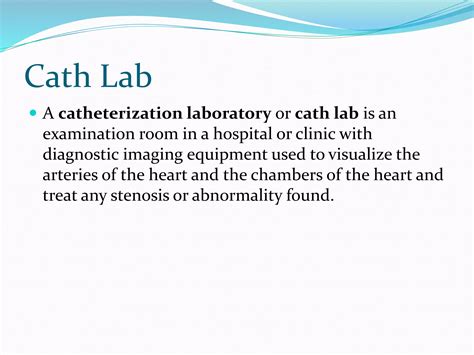The world of medical procedures can be complex and intimidating, but understanding what goes on behind the scenes can help alleviate fears and uncertainties. One such crucial area in hospitals is the Catheterization Laboratory, commonly referred to as the Cath Lab. This is a specialized department where doctors perform minimally invasive tests and procedures to diagnose and treat cardiovascular diseases. In this comprehensive guide, we will delve into the world of the Cath Lab, exploring its functions, the procedures it facilitates, and the advanced technology that makes these life-saving interventions possible.
What is a Cath Lab?
A Cath Lab is essentially an operating room equipped with specialized imaging equipment that allows doctors to visualize the arteries and chambers of the heart. It is here that cardiologists and radiologists perform a variety of diagnostic and interventional procedures. These procedures are designed to be minimally invasive, meaning they are performed through small incisions or punctures in the skin, reducing recovery time and minimizing the risk of complications.
Historical Evolution of the Cath Lab
The concept of the Cath Lab has been around for several decades, with the first cardiac catheterization performed by Werner Forssmann in 1929. However, it wasn’t until the 1950s and 1960s that the technology began to advance more rapidly. The development of angioplasty by Andreas Gruentzig in 1977 marked a significant milestone, ushering in the era of interventional cardiology. Since then, advances in imaging technology, catheter design, and pharmacological agents have transformed the field, enabling the treatment of a wide range of cardiovascular conditions with unprecedented precision and safety.
Procedures Performed in a Cath Lab
The Cath Lab is a versatile environment where various procedures are conducted. Some of the most common include: - Coronary Angiography: This involves injecting a special dye into the arteries to visualize any blockages on an X-ray. It’s a critical diagnostic tool for coronary artery disease. - Angioplasty and Stenting: When a blockage is found, a balloon can be used to open up the artery (angioplasty), and a stent (a small, wire mesh tube) can be placed to keep the artery open. - Cardiac Catheterization: This procedure involves measuring the pressure in the heart’s chambers and taking blood samples to analyze oxygen levels. - Pacemaker or Implantable Cardioverter-Defibrillator (ICD) Implantation: Devices that help regulate heart rhythm are implanted in the Cath Lab. - Ablation: A procedure used to treat irregular heartbeats (arrhythmias) by destroying the faulty electrical pathways in the heart.
Advanced Technology in the Cath Lab
The Cath Lab relies on sophisticated technology to enable precise diagnoses and treatments. Key among these are: - Digital Subtraction Angiography (DSA): Enhances the visibility of blood vessels by subtracting motion and other background noise from the image. - Intravascular Ultrasound (IVUS): Uses high-frequency sound waves to produce images of the inside of blood vessels, providing detailed information about the vessel wall and plaque composition. - Fractional Flow Reserve (FFR): Measures the pressure differences across a coronary artery stenosis to determine its significance. - Rotational Atherectomy: A technique used to treat heavily calcified coronary lesions by using a small, diamond-coated Burr that rotational ablates the calcified plaque.
Decision Framework for Patients
For patients facing the prospect of a Cath Lab procedure, understanding the process and what to expect can significantly reduce anxiety. Here are key points to consider: - Pre-procedure Preparation: Typically involves fasting, stopping certain medications, and arranging for someone to drive you home afterward. - The Procedure Itself: Will involve local anesthesia, and you may be awake or lightly sedated. The procedure can vary in length but usually takes about an hour. - Recovery: You’ll be monitored in a recovery area for a few hours to ensure there are no complications. Most patients can return home the same day. - Aftercare: Follow your doctor’s instructions carefully, including any medication regimen and follow-up appointments.
Frequently Asked Questions
What should I expect during a Cath Lab procedure?
+You will lie on a table, and the area where the catheter is inserted (usually the groin) will be cleaned and numbed with local anesthesia. You may feel some pressure as the catheter is inserted, but it should not be painful. Throughout the procedure, you will be monitored by a team of healthcare professionals who will explain what is happening and answer any questions you may have.
How long does it take to recover from a Cath Lab procedure?
+Recovery times can vary depending on the procedure, but most patients can return home the same day. It's generally recommended to rest for a day or two and avoid strenuous activities, such as heavy lifting or bending, for a week. Your doctor will provide specific instructions based on your procedure and overall health.
Are Cath Lab procedures safe?
+Like any medical procedure, Cath Lab interventions carry risks, including bleeding, infection, and reactions to the dye used. However, these procedures are considered safe when performed by experienced professionals in a well-equipped facility. Discussing your specific risks and benefits with your doctor can help you understand what to expect and how to minimize potential complications.
Conclusion
The Cath Lab is a cornerstone of modern cardiology, offering a wide range of diagnostic and therapeutic options for patients with cardiovascular diseases. By understanding the procedures, technologies, and precautions involved, patients can better navigate their care, making informed decisions about their health. As medical technology continues to evolve, the Cath Lab will likely remain at the forefront of innovative treatments, providing hope and improved outcomes for those affected by heart disease.



